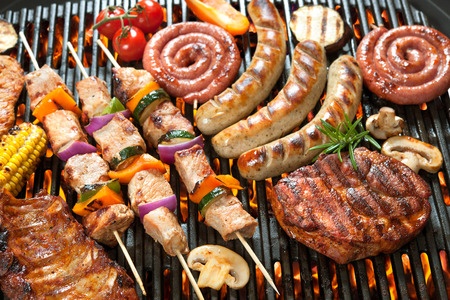
The UK’s Food Standard’s Authority (FSA) has published guide lines on its web-site for all those using the barbecue on the Bank Holiday Monday. Frankly, it doesn’t matter of course when you get the barbecue as long as you prepare and cook food in a manner which makes it safe enough for you and the family to eat. I’ve often eaten dodgy looking meat items which have been badly charred on one side and rather raw on the other.
In the UK about 33 million of us (51% of the population) are probably going to be attending a barbecue this year. One snapshot online survey of 2,000 UK adults in 2017 conducted by Censuswide between 8th and 14th May found surprising levels of ignorance about our understanding of well cooked barbecue meat. The survey showed 43% of us have often been served (if not eaten) undercooked meat in some form or another. The implication is that potentially 1 million cases of food poisoning could occur from undercooked or just badly cooked meat. That survey also revealed that even though a third of people (33%) are concerned about food hygiene at barbecues, most do not check the meat properly before serving it. Apparently, 61% don’t check there is no pink meat inside (although I do like it a bit rare myself !), 63% don’t check that the juices run clear and 84% don’t check that the meat is steaming hot.
Food poisoning cases tend to rise in the summer. The cases are down to Campylobacter usually with chicken, E. coli, Listeria and Salmonella.
The FSA has produced some great tips as part of its ‘safe Summer Food’ activity for all those cooking meat on a barbecue.
- Pre-cook. Best to cook all meats in the oven. All parts of it should be cooked through. Then, finish it off on the barbecue to get those charred, chargrilled or smoky flavours. The guests will not really notice the difference ! I do this for chicken, pork and sausages although all food items need to be processed in this way.
- Check that there is no pink meat visible and juices run clear. It means cutting food open to inspect it and properly. Move food around the barbecue and turn it over and round regularly so that there is even cooking. Clearly, don’t overdo it so be sensible but it pays to look. The food should be hot throughout.
- Store raw meat separately and don’t mix with already cooked meats. Standard practice frankly because cross-contamination is one of the main problems with transferring food poisoning bugs from one food item to another.
- Cold foods must be stored below 5°C and hot foods above 63°C. Sound advice as in between is a great temperature zone for harmful bacteria to survive and multiply.
- Plates and cutlery should be separated from raw meat and fish.
- Disposable barbecues take longer to heat up and cook food through.
Heather Hancock, Chair of the FSA Board said:-
“When you’re at a barbecue, remember that most types of meat should be cooked thoroughly to prevent food poisoning. A beef burger, for example, isn’t like a steak – it has bacteria present throughout. To make it safe to eat when prepared at home, it must be cooked through. Some restaurants are able to offer their customers burgers less than thoroughly cooked, but only because they have strict controls in place that are regulated and checked by enforcement officers.”
For more information visit: https://www.food.gov.uk/safe-summer-food.
Leave a Reply